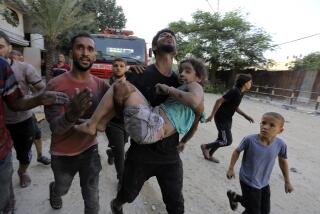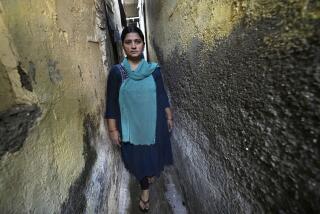India Fights History and Poverty to Give Children a Living Chance
- Share via
WASHINGTON — Driving through India is marvelously deceptive. Along Haryana highways, the proudly moving camels, pulling or carrying great loads, give the flat landscape a dimension of dignity. Majestically plumed wild peacocks float low and the traveler thinks about the imperial India of yore. Wheat, millet and rice fields are a symphony of colors, lovely and romantic from the car window. Then the visitor spends time in a village, attending the sights and sounds of Indian rural life. Illusion vanishes. Yet these are grounds for new hope.
Savitri Yadan came to live in dusty, hot Manethi as a teen-age bride less than a generation ago. In those days, 20 to 22 infants out of 100 died each year before their first birthday. But today the death rate has been halved, Yadan explains; other village mothers sitting on the dirt floor of the community center nod vigorously.
What has happened in Manethi is gradually happening in much of India--atrocious infant- and child-mortality rates are finally beginning to go down. This is perhaps the most fundamental positive news from the Third World in contemporary history.
Manethi is one of India’s 570,000 villages, located in the southernmost tip of Hariana State on a tongue of land jutting into the arid desert state of Rajasthan. Haryana’s 15 million people, among India’s 800 million, fit the national profile: 75% of them in rural areas with very high birthrates, overall bad health, malnutrition and shocking illiteracy.
The average Manethi family income is 3,500 rupees a year, about $230. The cost of a water buffalo or a camel, to put income into perspective, is around 4,000 rupees. People in Manethi make their livings from agriculture--some own parcels of land, others are landless peasants employed by neighbors. Buffaloes and camels are vital for tilling and transportation. Yet a whole family must work all year to earn the equivalent of the price of an animal; this, too, is illusory because a family spends everything it earns just to stay alive.
The villages lack running water and sewers; septic-tank latrines are only now being introduced here and there. Raw sewage runs down the center of the main streets--and children often play in it under the scorching sun.
Speaking in the Haryani language through an interpreter, Yadan said that the reduction in the deaths of infants and children under the age of 5 in her village was largely due to the immunization programs aggressively conducted by the Indian government with the crucial support of the United Nations Children’s Fund.
UNICEF leads the worldwide campaign to immunize Third World children against the six killer diseases--tuberculosis, whooping cough, diphtheria, polio, measles and tetanus--by 1990. Along with UNICEF, India is also trying to control diarrhea, the leading cause of child deaths (4 million worldwide in 1987), by providing safe drinking water and by offering oral rehydration therapy (packets of salt and sugar) to children already afflicted.
When children do survive, parents who would traditionally have five or more offspring nowadays rarely have more than three. Yadan’s enthusiastic report was a great oversimplification because India’s--and even Manethi’s future--cannot be resolved by immunizations alone. Forty years after independence from Britain, India has doubled its population, compounding the eternal problems of poverty, disease and hunger.
In India, as elsewhere in the Third World, parents compensate for the premature death of babies by procreating more and more, especially in the countryside. Adding children is a pathetic form of insurance against a family finding itself short of labor in the fields. Agricultural child labor is a fact of life in India.
According to UNICEF, close to 15 million children die annually in the Third World, mainly from preventable causes. Prevention in this sense means access to potable water to avoid contagion and gastric illness; proper nutrition for pregnant mothers, infants and children, and spacing of pregnancies so that babies are not born below the minimal 2.5 kilogram (5 1/2 pound)weight considered safe by the World Health Organization.
James P. Grant, UNICEF’s executive director, told a New Delhi audience that “it is obscene” when nearly 40,000 kids must die daily. But 40,000 daily deaths remain an abstraction for most of the world and most of the media. The 1984 chemical plant explosion at Bhopal, India, caused only 2,500 deaths and it was front-page news for days. But it is not news when thousands upon thousands die day after day in the Third World: That is part of everyday life.
Grant said that if India maintains and accelerates all its national health and children-saving programs, the death-toll could be cut by one-third in 1991--and that the number of births would at last be dropping accordingly, or more.
Yet the great task of saving India must be achieved through the grass roots, not through fiat from above--not even through outside helpers and advisers.
More than half of India’s rural population and 40% of the urban population live below the official “absolute poverty level,” defined by daily calorie intake. In India, the calorie intake is only 96% of the required minimum for healthy survival. Hunger rules the villages and the vast urban slums of Bombay, Calcutta and New Delhi, producing skeletal adults and malformed children.
Between 1980 and 1986, about 33% of children under five suffered from mild malnutrition and 5% from severe malnutrition. When drought hits India, as it did in 1987 and as it continues in the central belt as the worst drought in half a century, then the hunger grows.
Children under the age of 15 make up about one-third of India’s population--they are the survivors. But because of malnutrition, disease and harrowingly hard work, an Indian child’s life expectancy at birth in 1986 was only 57 years (it is 78 in the United States). A basic precondition for health--and child survival--in the Third World is safe drinking water, but in India less than half the rural population enjoys access to potable water.
Experts insist that education is key, both for national economic development and the survival of infants. In matters of basic child care and the prevention of infant death, the crucial difference is a mother’s understanding of the basic precepts of health--knowing enough to reject unhygienic practices and millennial traditions. To change old ways, a woman should be able to read. But by tradition in the rural areas, it is much less important for girls than for boys to be educated--another aspect of the Indian tragedy. Only 29% of the women in the countryside are literate, compared with men’s literacy at 57%. Only 38% of all Indian children completed grade school in 1986.
A UNICEF-supported study of Haryana villages by a young Indian scholar, Purnima Mankekar, addressed the education problem. She summed up by saying that unsanitary living conditions and absolute apathy toward environmental hygiene were the biggest obstacles to community health. Most people, for instance, persist in drinking water from wells fed by filthy ponds. They prefer it to piped chlorinated water available in a number of Haryana villages from nearby hydroelectric projects because, as Mankekar reported, most villagers believe “tap water is ‘lifeless’ and tastes bad.”
Villagers bathing in slime-edged ponds--also washing their buffaloes and cows in them--are a common sight along Indian highways. The wells for drinking water are often next to these ponds. Indian doctors say the wells contain “seepage,” making them full of pollution and responsible for gastric infections.
Outdoor defecation may be the single greatest health hazard in India. The habit persists in villages as well as in urban slums where hundreds of thousands of India’s poor live and sleep on sidewalks with no access to latrines.
Basantpur is a grim village of 350 houses and 4,000 inhabitants. An elder with a grizzly beard showed me several indoor latrines built after the government supplied septic tanks and connecting tubes. Yes, he said, people were beginning to use them. Dr. Sunder Lal, a physician and my guide, said, “This is doing away with customs of centuries and centuries--getting up in the morning and strolling over to one’s fields to relieve oneself in nature’s surroundings . . . and villagers think that it is healthier than being confined in a latrine.”
Education has to deal with religion and ancient customs to bury old superstitions and fears. One of India’s great tragedies is the awesome pollution of its rivers--by industrial waste and human religious waste.
Describing the holy river Ganges, a report by the New Delhi Centre for Science and Environment warned that a stretch near the city of Varanasi “where 6 million devotees bathe every year is contaminated by incredible amounts of biological and chemical filth.” The report said that about 40,000 human bodies are burnt annually at two cremation facilities along the waterway; the ashes are dumped into the river. “In accordance with tradition,” it continued, “unburnt bodies of saints, lepers and animals are thrown into the river--an estimated 60,000 carcasses of cows, dogs and buffaloes are dumped annually.”
If women’s education is the key to improving the equation of life and death, the condition of women is pivotal. But Indian women are still treated like beasts of burden. In Manethi, I saw local women working at a textile center, producing mats and T-shirts. I asked my guide how often and how long the women worked. “They can only spend a few hours a week here,” said the guide, “when they’ve finished their domestic work and their field work.” Manethi women, like women everywhere in rural India, rise before dawn to collect scarce firewood, cook breakfast for the family, work all day in the fields, return to cook the evening meal, clean up--and then earn a few extra rupees at the textile shop.
When industrial jobs opened up in Haryana towns, men from the villages rushed to take them--and women’s farm labor increased proportionally. Most Indian researchers agree that rural women work at least 14 hours a day--every day--and sometimes more, even if they are pregnant. A recent study of “Infant Mortality in India,” edited by population experts Anrudh K. Jain and Pravin Visaria, concluded that “education, to have the necessary impact, must be supplemented with measures for a more equitable environment for females.”
More to Read
Sign up for Essential California
The most important California stories and recommendations in your inbox every morning.
You may occasionally receive promotional content from the Los Angeles Times.










